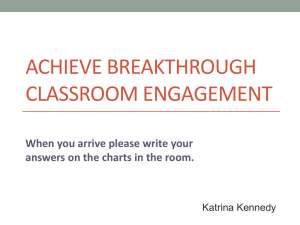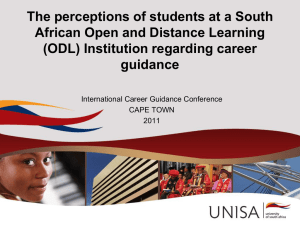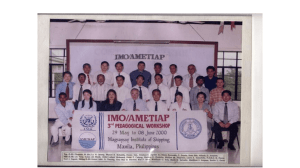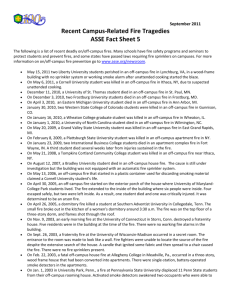Undergraduate Communities of Practice
advertisement
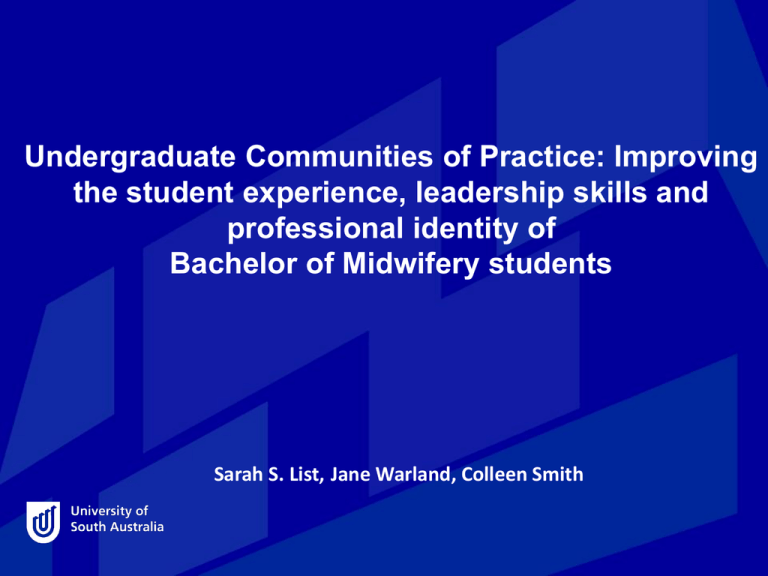
Undergraduate Communities of Practice: Improving the student experience, leadership skills and professional identity of Bachelor of Midwifery students Sarah S. List, Jane Warland, Colleen Smith The Healthcare Reality •By 2025: Australia faces a drastic shortfall in nurses and midwives •Compounded issue: students choosing to exit study Why are they leaving? •feelings of disconnect: university and profession •make few friends How can a sense of community help? • Trust built with learning communities • lowers sense of risk • increases engagement and activity Student communities On campus: ↓ likely to drop out, better levels of academic success BUT Online access & timetable flexibility = ↓ time spent on campus ↓ likely to make friends Online: lack structure, moderation, behavioural issues Growth in off-campus flexible study Almost 30% of students at UniSA study at least one course online UNISA 1 Online course 28% Fully off-campus 11% Mature >30yo 25% This Project: Created communities Aim: to determine the theoretical and practical roles of undergraduate Communities of Practice, and the structural and practical issues of developing and implementing one Research plan: Action Cycle Evaluating Planning Acting Observing McTaggart; Greenwood. Planning: Literature review for community design Previous use of learning communities? Types of communities? Student initiated and run communities • Face to face: ‘hidden’ from academics • Online: ‘hidden’, tends to be short term practical information Academic initiated communities: • Year level or small class group • Often cease after course/year/project completed Communities of Practice (CoP) "...are groups of people who share a concern or a passion for something they do and learn how to do it better as they interact regularly” The Domain: member connected via a shared domain of interest The Community: they engage in joint discussions, share information, and learn and support from each other The Practice: members are practitioners that develop a repertoire of resources, experiences, tools, and ways of addressing reoccuring problems i.e: shared practice Needs to be ongoing (Wenger, 2006.) How to build an active, engaged community? "...are groups of people who share a concern or a passion for something they do and learn how to do it better as they interact regularly” Wenger 2006 • Need an identity and to establish a sense of identity early: Bachelor of Midwifery students (cohort size: 342 Jan 2013) • 1 year UniSA development grant How have CoPs been used? Professionals - lots! Undergraduates.... little Lots of unanswered questions • How to build an active, engaged community? • Facilitation: Peer vs academic? • Structure? • Location? Engagement is linked to facilitation Staff directed Garrison's Community of Inquiry less community commitment by members • post quality? • unlikely to continue to contribute after specific use • facilitation? • Link to assessment (carrot and stick) To be a sage, guide or ghost? (Mazzolini and Maddison, 2002) Engagement is linked to facilitation Student directed? Baran and Correia (2009) Student leaders were inspirational, motivated students to participate and provided a risk-free environment. Correia and Davis (2008) When led by students, interactions were more meaningful and created a stronger sense of community Poole (2000) Student facilitation resulted in longer and a greater number of postings** Partnered Community Leadership McDonald et al (2012) ‘nurtured’ CoP Direct activities/ content/ moderate/ advocate. **time Review and advise Student Consultation Panel (9 students) Reference Group Research Team Support and review of project Community location - online 20% of UNISA’s total enrolments study in the SoNM • • • • SoNM UNISA 1 Online course 64% 28% Fully off-campus 21% 11% Mature >30yo 40% 25% 300 Midwifery students Students are time poor Midwifery Accreditation: 50% of time in placement Following births – on campus classes may be missed Creating the Community Students did NOT want facebook for their platform Informal groups already present, but no academic rigour and issues around behavioural guidelines. • Technical: easy to create and maintain • Login: no special account required We: Evaluated platforms (Weebly, Dolphin, Google communities, Wordpress, Buddypress, yammer, wikispaces, ning, meetup) comim.weebly.com Website areas chosen to encourage debate but link to assessment themes Encouraging activity Amount of activity in online spaces in an ongoing issue • Link to assessment reward? •"Students learn what they care about" (Biggs 1989) Relevance to study not enough. ‘Distance’ to the community Encouraging activity – Recreated in facebook More members and viewers But few posters/responders Content type did not influence response rates Outcomes Evaluative studies: broader cohort and more activity Time commitments ongoing issue (panel and general members) - professional programs have lower engagement rates) (Alsford et al.) Timing of project - facebook student group already present (50 members) Needs of the group: student version focuses on - assessment issues - pregnant ladies - Humour Read, but may not contribute Selected references • Wenger, E. (2006). Communities of practice: a brief introduction. www.ewenger.com/theory/communities_of_practice_intro.htm • Baran E, and Correia A. (2009). Student Led facilitation strategies in online discussions". Distance Education. 30. • Biggs, J. B. (1989). Approaches to the enhancement of tertiary teaching. Higher Education Research and Development, 8(1), 7-25. • Correia, A. P., & Davis, N. (2008). Intersecting communities of practice in distance education: the program team and the online course community. Distance Education, 29, 289-306. • Poole, D. M. (2000). Student participation in a discussion-oriented online course: A case study. Journal of Research on Computing in Education, 33(2), 162-77. • Garrison, D.R., Anderson, T., and Archer, W. (2001). Critical thinking, cognitive presence and computer conferencing in distance education. American Journal of Distance Education. 30, p339-361. • Mazzolini, M., and Maddison, S. (2003). Sage, guide or ghost? The effect of instructor interventionon student participation in online discusion forums. Computers & Education. 40, pp237-253 • University of South Australia Development Grant.

